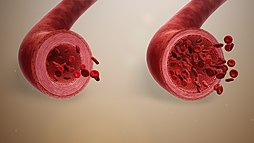
Back توسع الأوعية Arabic Вазадылатацыя Byelorussian Vazodilatacija BS Vasodilatació Catalan Vasudilatazioni Corsican Vazodilatace Czech Vasodilatation Danish Vasodilatation German Vazodilatado Esperanto Vasodilatación Spanish
This article needs more reliable medical references for verification or relies too heavily on primary sources. (March 2021) |  |

Vasodilation, also known as vasorelaxation, is the widening of blood vessels.[1] It results from relaxation of smooth muscle cells within the vessel walls, in particular in the large veins, large arteries, and smaller arterioles.[2] Blood vessel walls are composed of endothelial tissue and a basal membrane lining the lumen of the vessel, concentric smooth muscle layers on top of endothelial tissue, and an adventitia over the smooth muscle layers.[3] Relaxation of the smooth muscle layer allows the blood vessel to dilate, as it is held in a semi-constricted state by sympathetic nervous system activity.[2] Vasodilation is the opposite of vasoconstriction, which is the narrowing of blood vessels.
When blood vessels dilate, the flow of blood is increased due to a decrease in vascular resistance and increase in cardiac output[further explanation needed]. Vascular resistance is the amount of force circulating blood must overcome in order to allow perfusion of body tissues. Narrow vessels create more vascular resistance, while dilated vessels decrease vascular resistance. Vasodilation acts to increase cardiac output by decreasing afterload, −one of the four determinants of cardiac output.[4]
By expanding available area for blood to circulate, vasodilation decreases blood pressure.[5] The response may be intrinsic (due to local processes in the surrounding tissue) or extrinsic (due to hormones or the nervous system). In addition, the response may be localized to a specific organ (depending on the metabolic needs of a particular tissue, as during strenuous exercise), or it may be systemic (seen throughout the entire systemic circulation).[2]
Endogenous substances and drugs that cause vasodilation are termed vasodilators. Many of these substances are neurotransmitters released by perivascular nerves of the autonomic nervous system[6] Baroreceptors sense blood pressure and allow adaptation via the mechanisms of vasoconstriction or vasodilation to maintain homeostasis.[2]
- ^ "Definition of Vasodilation". MedicineNet.com. 27 April 2011. Archived from the original on 5 January 2012. Retrieved 13 January 2012.
- ^ a b c d Thomas GD (March 2011). "Neural control of the circulation". Advances in Physiology Education. 35 (1): 28–32. doi:10.1152/advan.00114.2010. PMID 21385998.
- ^ Tucker WD, Arora Y, Mahajan K (2024). "Anatomy, Blood Vessels". StatPearls. Treasure Island (FL): StatPearls Publishing. PMID 29262226. Retrieved 22 March 2024.
- ^ Cite error: The named reference
Vincent_2008was invoked but never defined (see the help page). - ^ Ramanlal R, Gupta V (2024). "Physiology, Vasodilation". StatPearls. Treasure Island (FL): StatPearls Publishing. PMID 32491494. Retrieved 22 March 2024.
- ^ Sheng Y, Zhu L (2018). "The crosstalk between autonomic nervous system and blood vessels". International Journal of Physiology, Pathophysiology and Pharmacology. 10 (1): 17–28. PMC 5871626. PMID 29593847.